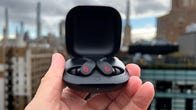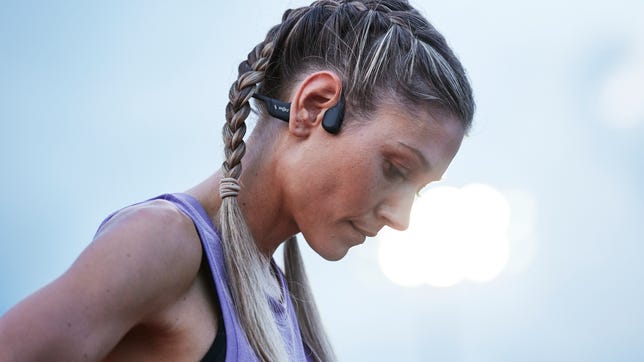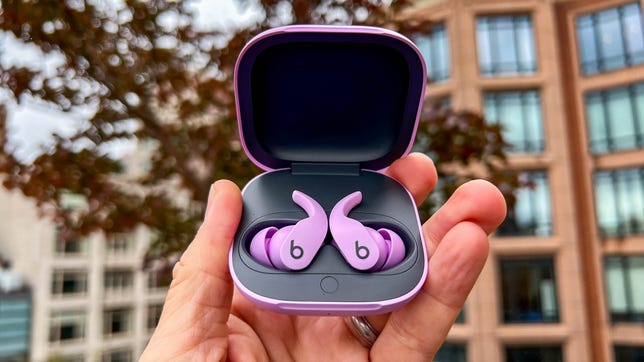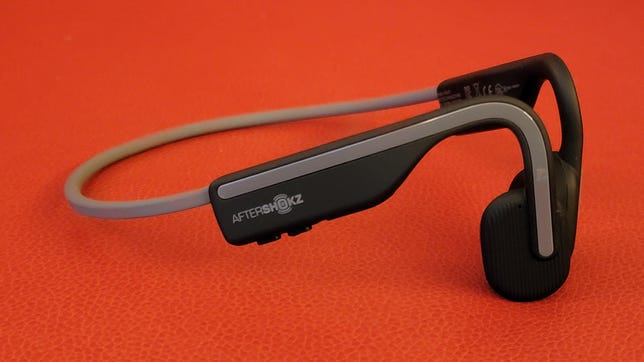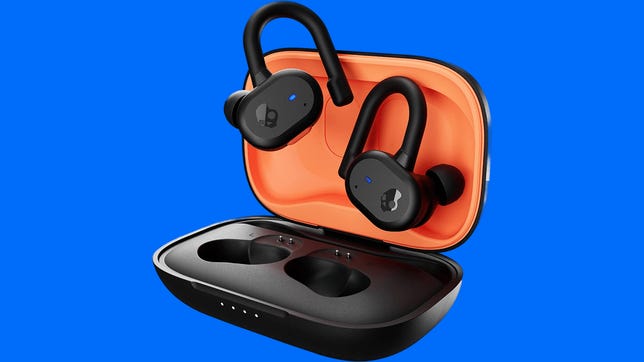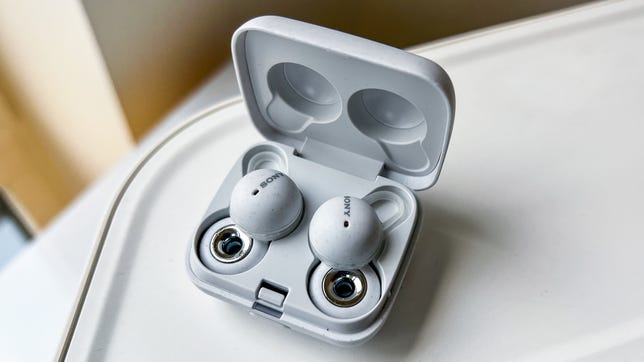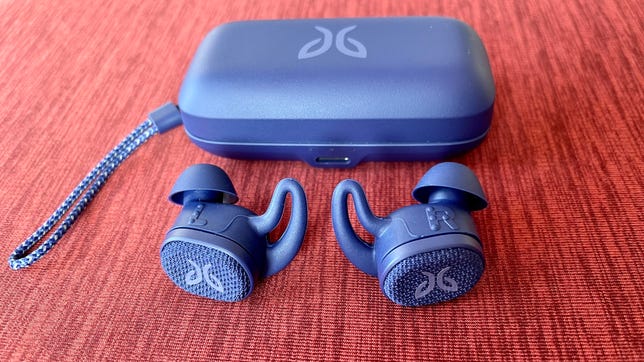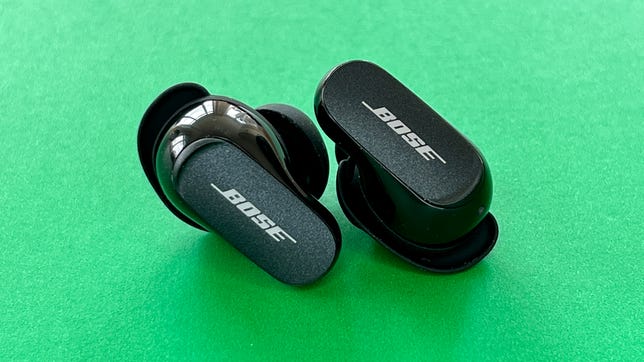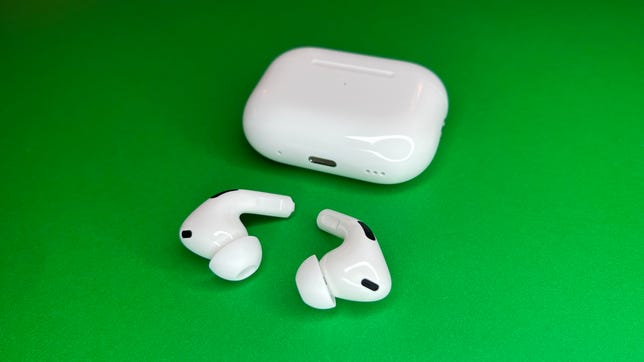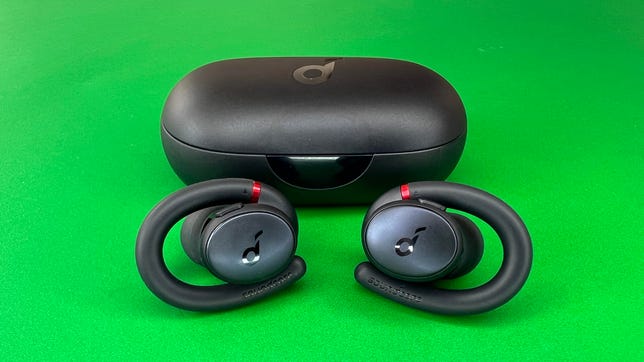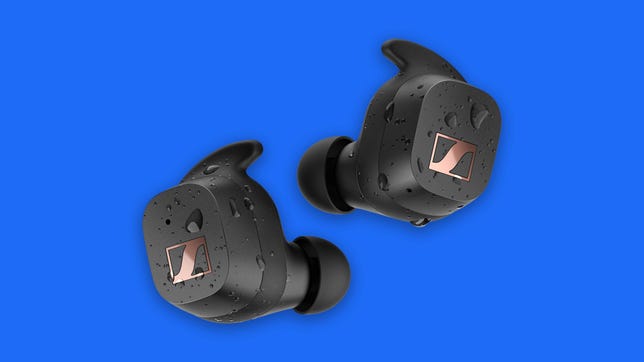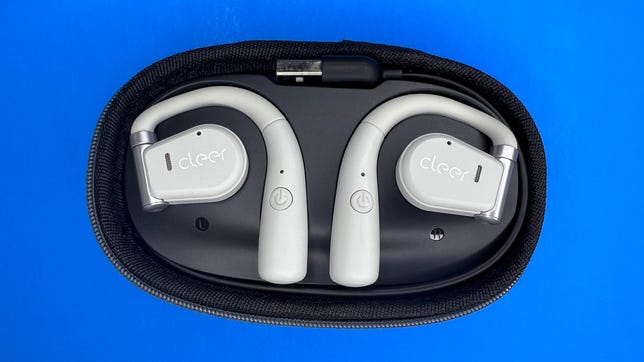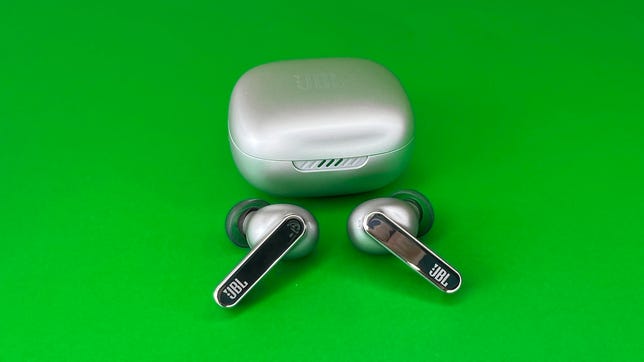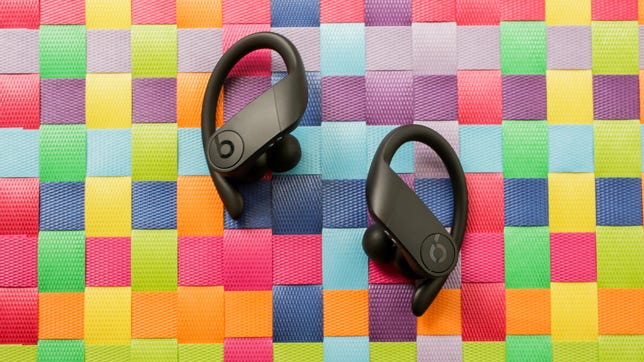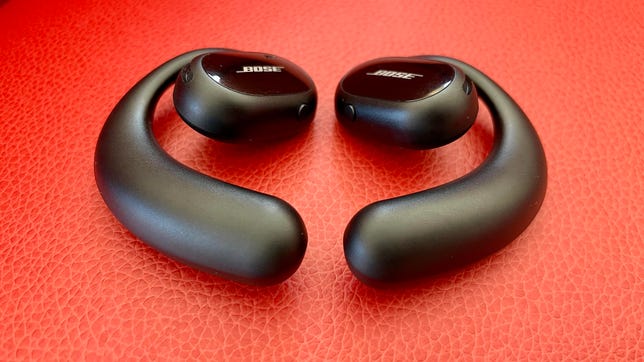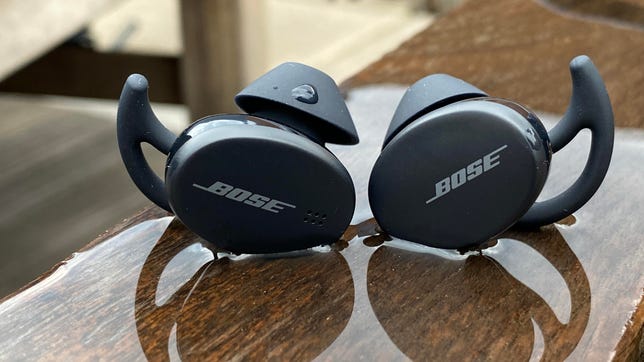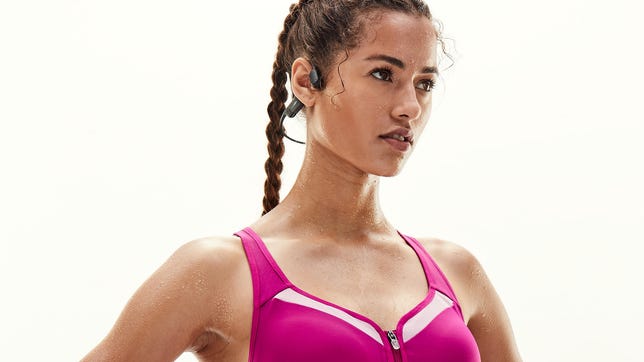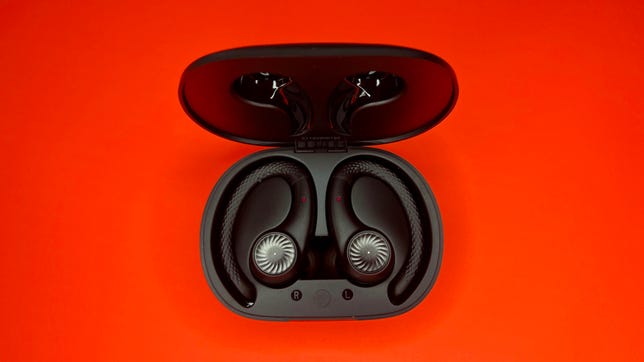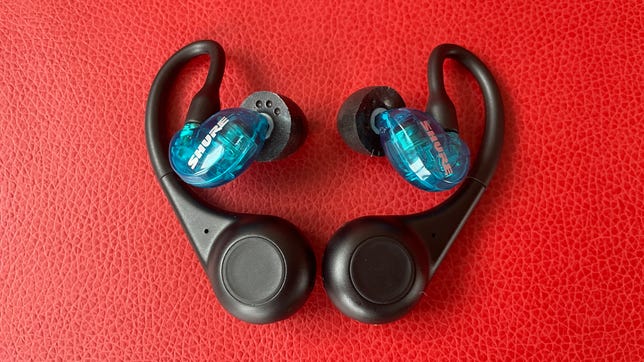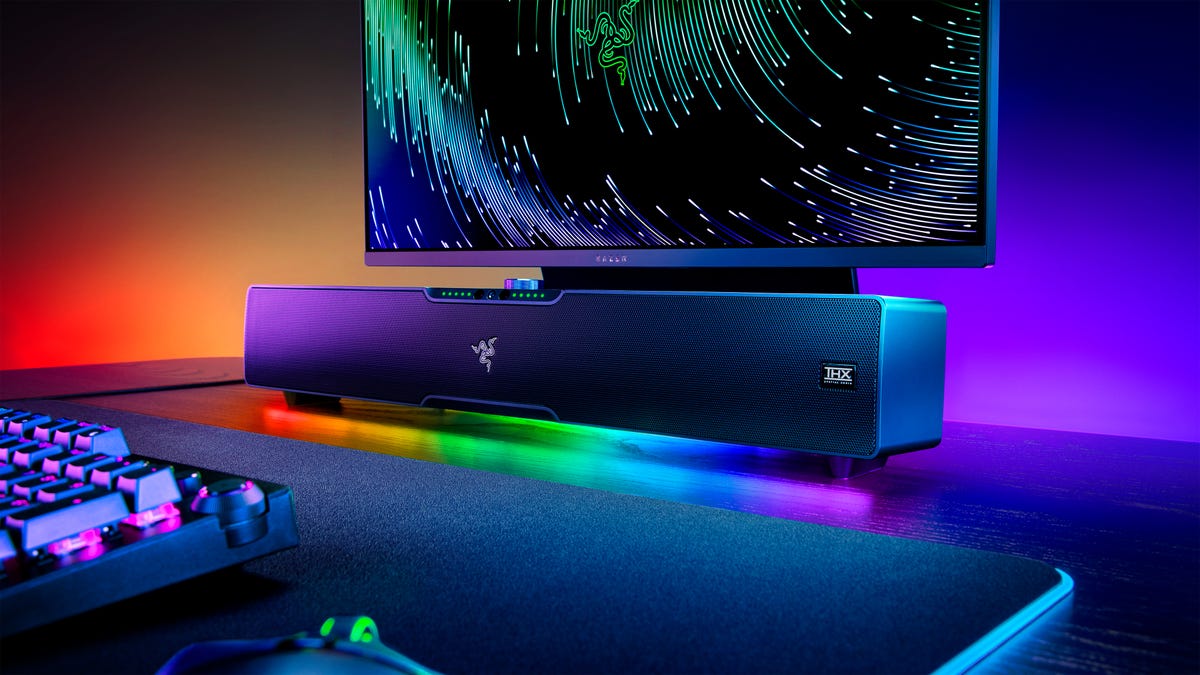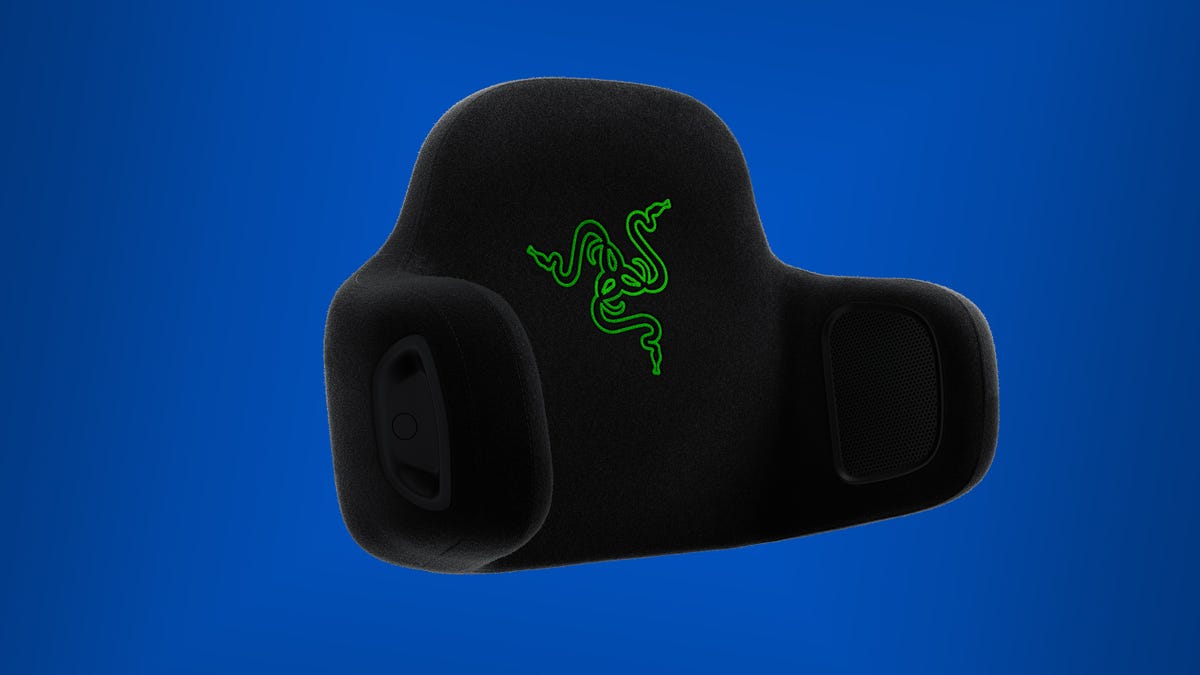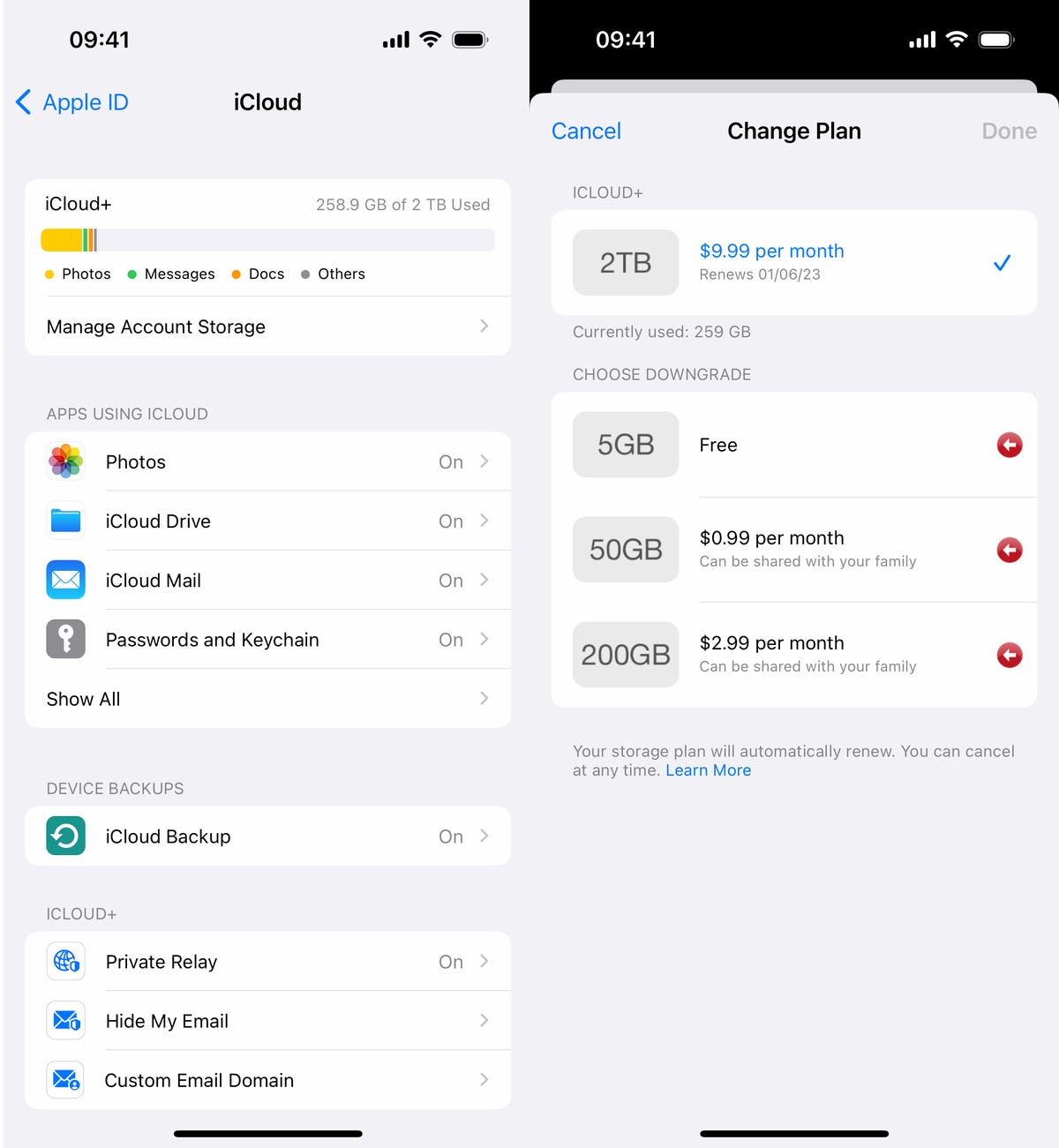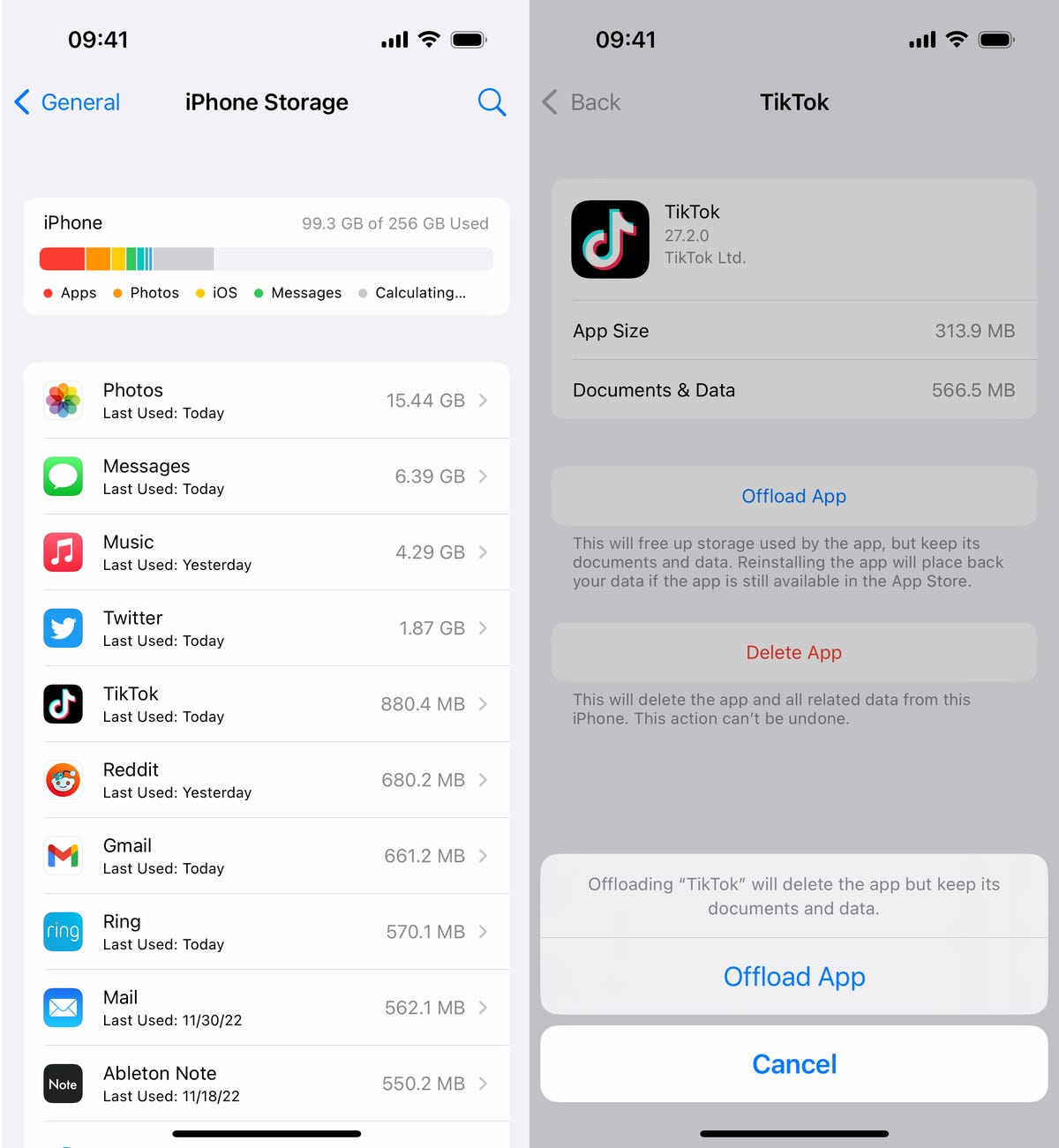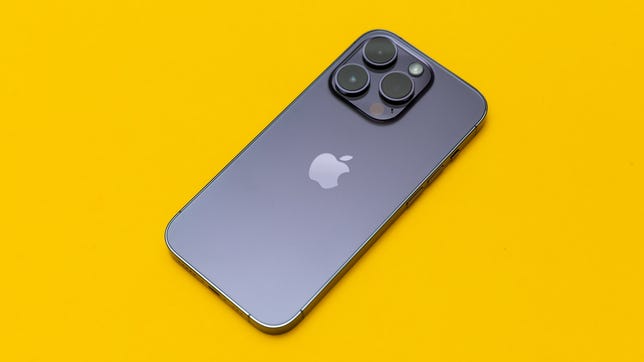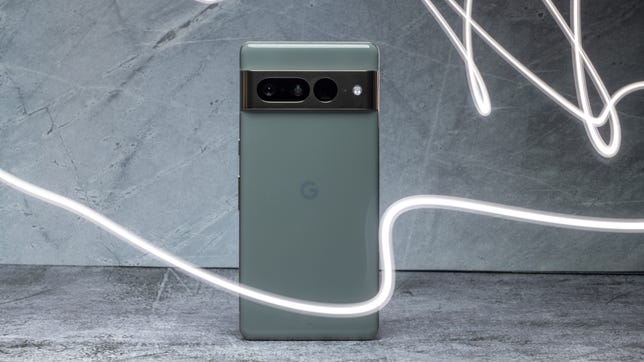Running is a rigorous activity, and not every pair of earbuds can withstand your exercise routines without falling out. The best earbuds for running are designed for runners who need their gear to stay in place, even while sprinting. Earbuds specifically designed for running usually have some sort of ear hook or sport fin for added security. Comfort, durability and sound quality are key factors. So too is some sort of transparency mode or an open design that allows you to hear ambient sound (and traffic) for safety reasons. Most noise-canceling earbuds now have a transparency mode that lets sound in, so look for that feature if you’ll be using them on a run.
The majority of the headphones for running on this best list are true wireless, but there are also a few other types, including around-the-ear wireless bone-conduction headphones that are popular with runners and bikers because their open design allows you to hear the outside world. Whether you’re looking for the best earbuds for running or the best running headphones, there’s something on this list that should work for you.
For this most recent update to the list, I’ve added a few new models of running headphones, including the Apple AirPods Pro 2, Bose QuietComfort Earbuds 2 and the Oraimo Open Ear Headphones, an alternative to bone-conduction models.
Now playing:Watch this:Beats Fit Pro are the sports AirPods you’ve always wanted
10:27
Shokz
AfterShokz has changed its name to Shokz and released new 9th-generation bone-conduction headphones that offer slightly improved bass performance compared with the company’s earlier flagship model, the Aeropex (now called the Shokz OpenRun). That makes the OpenRun Pro model the best bone-conduction headphones you can get right now, although they still can’t match the sound quality of traditional headphones.
Bone conduction wireless headphones don’t go on your ears — they actually deliver sound to your ear through your cheekbones. The big benefit of this technology as a safety feature for running is that, thanks to its open design, you can hear what’s going on around you — traffic noise in particular — while listening to music or having a phone conversation (yes, they perform well for voice calls). Also, some race coordinators don’t allow runners to wear anything in their ears, which is where headphones like this come in handy.
Like the Aeropex, the OpenRun Pro have a lightweight, wraparound titanium frame and are rated for up to 10 hours of music playback and you can get 1.5 hours of battery life from a 5-minute charge (they have a proprietary charging cable instead of USB-C, which is unfortunate). I found them comfortable to wear but you may have to adjust them on your head to relieve potential pressure points. While they do offer incrementally improved sound that’s a bit fuller with more bass, like other bone-conduction headphones these are strongest in the midrange where voices live so they’re very good for podcasts, talk radio, newscasts and audiobooks. For music, they’re only OK.
Note that Shokz makes other, more affordable bone-conduction headphones, including the OpenRun, if you don’t want to drop $145 on its current flagship model.
You’re receiving price alerts for Shokz OpenRun Pro
David Carnoy/CNET
Technically, the Beats Fit Pro ($200) aren’t AirPods, but they’re built on the same tech platform as the AirPods Pro (Apple owns Beats). Unlike Beats’ earlier and less expensive Studio Buds, the Beats Fit Pro include Apple’s H1 chip and have most of the AirPods Pro’s features, including active noise canceling, spatial audio, Adaptive EQ and a very good transparency mode that lets ambient sound in. I’d venture to call them the sports AirPods you’ve always wanted. And for some people, they might just be better than the AirPods Pro.
Read our Beats Fit Pro review.
You’re receiving price alerts for Beats Fit Pro
David Carnoy/CNET
Shokz’s OpenMove bone-conduction headphones list for $80 but are currently selling for $60. The OpenMove headphones have some small design upgrades over their predecessors. I found them comfortable to wear and while the sound isn’t great, it’s relatively good for a bone-conduction headphone (again, keep your sound quality expectations in check or you’ll be disappointed). They’re very good for listening to podcasts, audiobooks and news broadcasts while you run (I have a tendency to listen to XM radio while running).
This model charges via USB-C and includes a simple carrying pouch. Battery life is rated at up to 6 hours.
You’re receiving price alerts for Shokz OpenMove – Open-Ear Bluetooth Sport Headphones – Bone Conduction Wireless Earphones – Sweatproof for Running and Workouts, with Sticker Pack (Grey)
David Carnoy/CNET
With so many new wireless earbuds and headphones being released on what seems likely a weekly basis, it’s not easy for companies to differentiate their products in the marketplace. Skullcandy hopes its new voice-driven platform, Skull-iQ Smart Feature Technology, will do just that. Similar to the Apple AirPods’ “Hey, Siri” feature, Skullcandy’s version allows you to say, “Hey, Skullcandy” to issue hands-free voice commands without touching a button. Skull-iQ debuts on the sports-oriented Push Active and the $100 Grind Fuel earbuds, which will be firmware-updatable via the Skullcandy App.
With their ear-hook design, the Push Active earbuds are essentially a more affordable version of the Beats Powerbeats Pro and they fit my ears slightly better. I’m not usually a fan of ear-hook style buds, but this is one of the better versions.
The Push Active earbuds are equipped with Bluetooth 5.2, are IP55 splash-proof, have built-in Tile Finding Technology and are rated for up to 10 hours of battery life on a single charge at moderate volume levels.
You’re receiving price alerts for Skullcandy Push Active
Screenshot by David Carnoy/CNET
The one downside to bone-conduction headphones is that they just don’t sound great for music and tend to fall short most noticeably in the bass department. Oraimo’s Open Ear Headphones look like a bone-conduction model but instead have speakers built into them that fire sound into your ears. And that sound is better than what you get with bone-conduction headphones (it’s bigger with better bass performance). I wouldn’t say they sound quite as good as decent noise-isolating earbuds, but the sound is quite respectable and has a nice open quality to it because these are after all “open” headphones.
The Oraimo are more expensive than some similarly styled open-ear headphones you can find on Amazon. But these did seem durable and also are good for making calls, with solid background noise reduction. This style of headphone isn’t for everyone (some may find them slightly uncomfortable after longer listening sessions), but they do stay on your ears securely and allow you to hear the outside world for safety reasons. Battery life is rated at 16 hours at moderate volume levels and they’re splashproof.
You’re receiving price alerts for Oraimo Open Ear Headphones, Wireless Earbuds for Android & iPhone, Open Ear Earbuds, Built-in Mic,Sweat/Splash Proof, 16 Hrs Music Play, for Running Cycling Climbing with Deep Base
David Carnoy/CNET
Battery Life
Rated up to 6 hours
Noise Canceling
Yes (ANC)
Multipoint
No
Headphone Type
Wireless earbuds
Water-Resistant
Yes (IPX5 — protection against low-pressure water streams)
I was a fan of Earfun’s earlier Free Pro earbuds, which offer good sound for around $50 and have little sport fins that help keep them in your ears securely. Now Earfun has released the Earfun Pro 2 buds with aluminum alloy caps, improved noise canceling and a couple of extra microphones that help boost voice-calling performance.
The Free Pro 2 deliver good sound for their modest price (click to use the coupon), with decent clarity and deep but well-defined bass. They produce relatively big, open sound. They don’t have such extra features as an ear-detection sensor that would make it so your music automatically paused when you took one or both buds out of your ears or an app that would allow you to update their firmware. But they’re lightweight, should fit most ears well and have decent noise canceling along with a transparency mode. (It’s not as good as the AirPods Pro’s transparency mode, which is hard to beat.)
I found the voice-calling performance good but not great. The Free Pro 2 earbuds did an acceptable job of reducing background noise and picking up my voice in noisy environments, but they aren’t necessarily top-notch in this department. Battery life is rated at up to 6 hours, the earbuds are IPX5 splash-proof and their elongated, wirelessly charging case is compact, lightweight and better designed than the Free Pro case.
Note that you can save $20 at Amazon by activating the instant coupon located on the product page.
You’re receiving price alerts for Earfun Free Pro 2
David Carnoy/CNET
Battery Life
5.5 hours
Noise Canceling
No
Multipoint
No
Headphone Type
Wireless earbuds
Water-Resistant
Yes (IPX4 — splash-proof)
The LinkBuds are, in a sense, Sony’s answer to Apple’s standard AirPods. While they don’t sound as good as Sony’s flagship WF-1000XM4 noise-isolating earbuds, they offer a discreet, innovative design and a more secure fit than the AirPods, as well as good sound and very good voice-calling performance.
Like the third-gen AirPods, their open design allows you to hear the outside world — that’s what the ring is all about. That makes them a good choice for folks who want to hear what’s going around them for safety reasons or just don’t like having ear tips jammed in their ears. They also have a few distinguishing extra features, including Speak to Chat and Wide Area Tap. Instead of tapping on a bud, you can tap on your face, just in front of your ear, to control playback.
They’re IPX4 splash-proof and thanks to their fins — Sony calls them Arc Supporters — they lock in your ears securely and work well for running and other sporting activities.
Water-resistant: Yes (IPX4 rating — splash-proof).
Read our Sony LinkBuds review.
You’re receiving price alerts for Sony LinkBuds (Gray)
David Carnoy/CNET
The Jaybird Vista 2 sports buds are similar in design to the original Vista buds but have a couple of key upgrades: active noise canceling and a transparency mode called SurroundSense, which allows you to hear the outside world, an important safety feature for runners and bikers (as well as skiers).
The Vista 2 buds have an IPX68 water-resistance rating, which means they’re both dust-proof and fully waterproof. Jaybird says they’re also sweat-proof, crush-proof and drop-proof. And the compact case is now splash-proof and dust-resistant, with an IP54 rating.
They sound quite good once you tweak the EQ settings to your liking, but their sound quality isn’t quite up to the level of some other premium earbuds. Their noise-canceling, transparency mode and voice-calling are decent though unspectacular (the Beats Fit Pro earbuds perform better in all departments). But if you’re buying these, you’re buying them for the secure fit and durability.
You’re receiving price alerts for Jaybird Vista 2
David Carnoy/CNET
Battery Life
Rated Up to 6 Hours
Noise Canceling
Yes (ANC)
Multipoint
No
Headphone Type
Wireless Earbuds
Water-Resistant
Yes (IPX4 — Splash-Proof
Bose’s second-generation QuietComfort Earbuds 2 are not only about 30% smaller than their predecessors, but their case is about 40% smaller and truly pocketable. They feature best-in-class noise canceling and improved sound, thanks to Bose’s new CustomTune sound calibration system that customizes the sound for your ears. Voice-calling performance is also significantly better than that of the original QuietComfort Earbuds.
The other big change is to the ear tips. Bose has ditched its one-piece StayEar wing tips for a two-piece Fit Kit system that features separate ear tips and “stability bands” in three size options, giving you more flexibility to get a secure fit and tight seal. They’re IPX4 splashproof, and I found them very good for running as they stayed locked in my ears and have a good transparency mode to let you hear the outside world.
While they’re pretty pricey, Bose has begun to offer some discounts on them in flash sales.
Read our Bose QuietComfort Earbuds 2 review.
You’re receiving price alerts for Bose QuietComfort Earbuds 2
David Carnoy/CNET
Battery Life
Rated up to 6 hours
Noise Canceling
Yes (ANC)
Multipoint
No
Headphone Type
Wireless earbuds
Water-Resistant
Yes (IPX4 — splash-proof)
As long as you can get a good, secure fit, the lightweight AirPods Pro (2nd generation) make excellent earbuds for running and feature a top-notch transparency mode that allows you to hear the outside world (they now come with extra small ear tips for those with very small ears but Apple still doesn’t have XL tips for those with larger ears).
They’re powered by Apple’s new H2 chip, which delivers more processing power while being more energy efficient, according to Apple. The new chip, combined with new low-distortion drivers, allows for improved sound that offers better clarity and depth. The noise canceling is also improved — Apple says the new AirPods have “double” the noise canceling of the original AirPods Pro. Additionally, the new AirPods add an extra hour of battery life, up from five to six hours with noise canceling on. Plus, a speaker in the case that emits a sound that helps locate your buds via Find My should they decide to hide from you.
Read our Apple AirPods Pro 2 review.
You’re receiving price alerts for Apple AirPods Pro (2nd Gen, White)
David Carnoy/CNET
The new Soundcore Sport X10 have an interesting design with rotating swiveling ear hooks that flip up when you’re using them and flip down when you want to set them in their charging case, which has a smaller footprint than a lot of buds with ear hooks.
As long as you get a tight seal, they sound good, with powerful, punchy bass and good detail. They also have active noise canceling, which is effective though not as good as Sony or Bose’s noise canceling. They’re also fully waterproof with an IPX7 rating, which means they can be fully submerged in up to 3 feet of water for 30 minutes. Battery life is rated at up to 8 hours with an additional three charges in the charging case.
You’re receiving price alerts for Soundcore by Anker, Soundcore Sport X10 True Wireless Bluetooth 5.2 Workout Headphones, Rotatable Ear Hooks, Deep Bass, IPX7 Waterproof, Sweatproof, 32H Play, Fast Charge, Sport Earbuds, Gym, Running
Sennheiser
The Sport True Wireless earbuds are essentially Sennheiser’s CX True Wireless earbuds with sport fins (for a more secure fit) and better durability. They have an IP54 rating that makes them splash-proof and dust-resistant. The CX True Wireless (IPX4) don’t offer dust resistance.
These aren’t noise-canceling earbuds, but they do have an awareness mode that allows ambient sound to leak into the buds so you can hear what’s going on around you for safety reasons. They use Bluetooth 5.2 and have support for the AAC and AptX audio codecs. Battery life is rated at up to 9 hours at moderate volume levels with an additional two charges in the charging case (there’s no wireless charging).
Featuring clean and well-balanced sound with punchy bass, they sound very similar to the CX True Wireless and CX Plus True Wireless.
You’re receiving price alerts for Sennheiser Sport True Wireless
David Carnoy/CNET
Battery Life
Rated up to 7 hours
Noise Canceling
No
Multipoint
No
Headphone Type
Open-ear wireless earbuds
Water-Resistant
Yes (IPX5 — protection against low-pressure water streams)
Cleer’s Epic Arc buds are similar to Bose’s Open Sport Earbuds (see below) but are actually a little more comfortable to wear thanks to their swiveling hinge. Like the Bose buds, they rest on the top of your ear just above the ear canal and fire sound into your ears. They’re open so they let ambient sound in (that’s a plus if you’re a runner or biker and want to hear traffic), but their 16.2 mm drivers provide ample bass and volume. They don’t sound quite as good as the Bose Open Sport Earbuds but they’re pretty close.
I liked the case, which is a little big but pretty thin. While it has an integrated USB charging cable (that’s nice), like the Bose Open Sport Earbuds case it doesn’t have a rechargeable battery so it’s basically a dock for charging the earbuds, which are also available in black. Battery life is rated at up to 7 hours and they’re IPX5 splash-proof.
Some of these types of ear-hook-style earbuds have physical control buttons but these have touch controls. I found they worked pretty well but not great. The buds do have a companion app that allows you to upgrade the firmware and tweak the sound profile.
You’re receiving price alerts for Cleer Arc
David Carnoy/CNET
Battery Life
Rated up to 10 hours
Noise Canceling
Yes (Adaptive)
Multipoint
Yes
Headphone Type
Wireless earbuds
Water-Resistant
Yes (IPX5 — protection against low-pressure water streams)
Over the years, JBL has put out some decent true-wireless earbuds, but nothing that really got me too excited. That’s finally changed with the arrival of the Samsung-owned brand’s new Live Pro 2 and Live Free 2 buds. Both sets of buds — the Live Pro 2 have stems while the Live Free 2 have a pill-shaped design — offer a comfortable fit along with strong noise canceling, very good sound quality and voice-calling performance, plus a robust set of features, including multipoint Bluetooth pairing, an IPX5 splashproof rating and wireless charging.
The Live Pro 2 and Live Free 2 are equipped with the same 11mm drivers, six microphones, oval tubes and oval silicon tips. Aside from the design, the biggest difference between the two buds is battery life; the stemless Live Free 2 is rated for up to seven hours, while the Live Pro 2 is rated for 10 hours. The Live Pro 2 is available in four color options.
Read our JBL Live Pro 2 first take.
You’re receiving price alerts for JBL Live Pro 2
Sarah Tew/CNET
Battery Life
Rated up to 9 hours
Noise Canceling
No
Multipoint
No
Headphone Type
Wireless earbuds
Water-Resistant
Yes (IPX4 — splash-proof)
Yes, the Beats Powerbeats Pro’s jumbo charging case is a notable drawback. But the combination of incorporating all the features that make Apple’s AirPods great while delivering richer sound quality and better battery life in a wireless design that won’t fall out of your ear (ear hooks for the win!) ultimately is a winning proposition for earbuds for running.Just make sure you buy these running earbuds somewhere that has a good return policy in case you’re in the small minority that has ears that aren’t quite a match for the Bluetooth earbuds. Note that these headphones are frequently discounted and have been on the market for a few years, so you should only buy them if they are substantially discounted.
Read our Beats Powerbeats Pro review.
You’re receiving price alerts for Beats Powerbeats Pro (Black)
David Carnoy/CNET
As headphones go, Bose’s Sport Open Earbuds are pretty funky. Not to be confused with the company’s more traditional in-ear Sport Earbuds and QuietComfort Earbuds, they feature an open design without a tip, meaning the earpiece sits on top of your ear and doesn’t penetrate your ear canal.
Geared toward runners and bikers who want their ears open to the world for safety reasons — or to people who don’t like to have any sort of bud in their ears — they sound surprisingly good. I ended up liking them, but their design isn’t for everybody, and how comfortable you find them will determine how much you like them.
Alas, Bose has discontinued them. But they remain on sale at a discounted price.
Read our Bose Sport Open Earbuds review.
David Carnoy/CNET
Battery Life
Rated up to 5 hours
Noise Canceling
No
Multipoint
No
Headphone Type
Wireless earbuds
Water-Resistant
Yes (IPX4 — splash-proof)
Bose’s QuietComfort Earbuds and Sport Earbuds both make good workout earbuds, thanks to their StayHear Max tips and secure fit, but the Sport Earbuds are more compact and lighter and also more affordable (the QuietComfort Earbuds do have excellent active noise canceling, however).
They have the same IPX4 splash-resistance rating as the QuietComfort Earbuds, are equipped with Bluetooth 5.1 (my connection was rock-solid) and share a similar design aesthetic, with three color options available. Unlike their step-up sibling, they have no active noise canceling and 5 hours of battery life instead of 6 hours, and they don’t have wireless charging. While they do stick out from your ears, they’re noticeably smaller and lighter than the QuietComfort Earbuds and their case is about 30% to 40% smaller. The case still isn’t as small as the cases for such competitors as the AirPods Pro, but it feels reasonably compact.
Read our Bose Sport Earbuds review.
You’re receiving price alerts for Bose Sport Earbuds (Black)
Shokz
Battery Life
Rated up to 10 hours
Noise Canceling
No
Multipoint
Yes
Headphone Type
Bone conduction open-ear headphones
Water-Resistant
Yes (IP55 — protection against low-pressure water streams)
The headphones formerly known as the AfterShokz Aeropex are now the Shokz OpenRun. They don’t have quite as good sound as the flagship OpenRun Pro and they come with a soft case rather than a hard case, but they’re similar in many ways. The Aeropex model, which you can still find, includes two charging cables while the OpenRun includes only one (it’s proprietary rather than USB-C).
You’re receiving price alerts for Shokz OpenRun
David Carnoy/CNET
Battery Life
Rated up to 15 hours
Noise Canceling
No
Multipoint
No
Headphone Type
Wireless earbuds
Water-Resistant
Yes (IPX8 — can be fully submerged for long periods of time)
While the Tribit MoveBuds H1 only sound decent, not great, there’s a lot to like about them. They feel sturdy and are fully waterproof with an IPX8 rating. They also have very long battery life — up to 15 hours — and support Qualcomm’s AptX audio codec. Many Android smartphones offer AptX Bluetooth streaming.
You’re receiving price alerts for Tribit MoveBuds H1
Bose
Battery Life
Rated up to 8 hours
Noise Canceling
No
Multipoint
No
Headphone Type
Built-in with glasses
Water-Resistant
Yes (IPX4 — splash-proof)
The Bose Frames are one of those products you have to try in order to fully appreciate — or dismiss. The concept is that you’re getting a decent pair of sunglasses with a pair of headphones that don’t actually go in your ears. Rather, integrated micro speakers in each arm direct a beam of sound to your ears. That design could be appealing to people who don’t like having headphones in or on their ears, and also offers a degree of safety for runners and bikers who want their ears open to the world.
Bose has updated its line of audio sunglasses with three new models, including the Tempo sports model, which offers better sound and battery life than the more traditional-looking Tenor and Soprano. The Tempo has better specs all around, with USB-C charging and larger 22mm drivers. It also delivers up to 8 hours of battery life.
Their sound is definitely improved from the original Frames. Bose says the Tempo plays “deeper and louder — loud enough for cycling at 25 mph — while [you’re] still able to hear traffic and your training partners.” They’re sweat-, weather-, scratch- and shatter-resistant, according to Bose, and fit under most protective helmets. (I had no problem using them with a couple of bike helmets.) They also work really well for making calls, thanks to a new dual-microphone system. Optional lenses are available for $39 and you can order prescription lenses through Lensabl.
Read our Bose Frames review.
You’re receiving price alerts for Bose Frames (Tempo)
David Carnoy/CNET
Battery Life
Rated up to 8 hours
Noise Canceling
No
Multipoint
No
Headphone Type
Wireless earbuds
Water-Resistant
Yes (IPX4 — splash-proof)
I liked Shure’s original Aonic 215 true-wireless earbuds, but they were buggy and Shure pulled them off the market. From a design standpoint, the second-generation earbuds are essentially identical, but not all the performance kinks have been smoothed out.
Weirdly, they’re kind of the audiophile equivalent of the Beats Powerbeats Pro. They have a hook that wraps around the top of your ear and they stayed in my ears very securely (even more securely than the Powerbeats Pro earbuds). And like that Beats model, they have a jumbo charging case. Even though it’s technically bigger than the Powerbeats Pro’s case, it doesn’t feel bigger, perhaps because it’s slightly thinner.
What’s interesting about them is that the Bluetooth module is detachable (I liked the physical control button they have instead of touch controls). As the name implies, the Aonic 215 True Wireless Noise-Isolating Earphones incorporate Shure’s SE215 buds, the $99 model in its line of earbuds that have detachable cables. But the modules, which can be bought separately for $230, are designed to drive any Shure earbuds that have a detachable cable, including the $1,000 SE846.
Headset performance has improved (they’re now stereo rather than mono for calls) and they now have an IPX4 splash-proof water-resistance rating. They have clean, well-balanced sound with nicely defined bass — but they just don’t have a ton of bass. I’d like to see them cost about $50 less, but they do make for good sports earbuds that you don’t have to worry about falling out of your ears.
More earbud and headphone recommendations
More for fitness buffs






